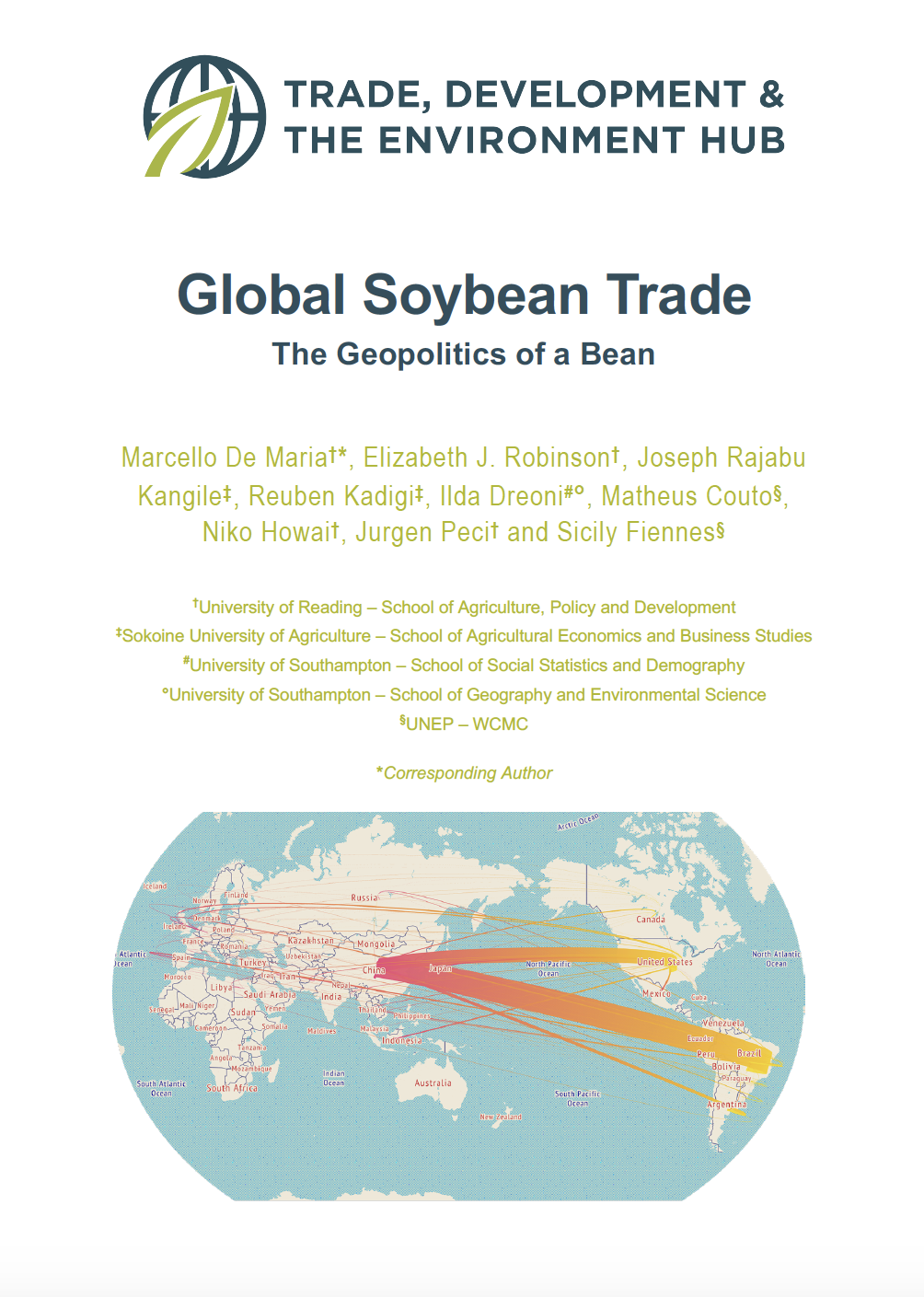The global soybean trade was worth about 9.5 billion of US dollars in 2000. By the end of this year – in 2020 – it is projected to exceed 60 billion[1]. This is just one of the many figures that explains why the last two decades might be remembered as the Great Soybean Expansion, the period when soybean became one of the most traded commodities in the world – but also one of the most controversial. While some have hailed the extraordinary growth of the soybean market as a “miracle”[2], mainly focusing their attention on aggregate agroeconomic figures and on the multiple uses of this crop, others have put the spotlight on the negative socio-economic and environmental consequences of the soybean expansion, often labelling this phenomenon as a “curse”, or as a “trap”[3].
Figure 1 – Global soybean trade flows in 2017

Source: De Maria et al., 2020, Global Soybean Trade – The Geopolitics of a Bean.
However, the critical question that needs to be addressed is not whether the current soybean expansion is either a miracle or a curse. This would actually be a misleading question, based on the assumption that the range of positive and negative impacts associated with soybean production, consumption and trade, are mutually exclusive. Instead, the underlying arguments of the soybean miracle and curse narratives are two faces of the same coin. The huge profits made by traders, agribusinesses and other stakeholders involved in the soybean industry, are as real as the negative socio-economic and environmental consequences, which – among others – include land (and meat) grabbing[4], deforestation[5], greenhouse gas emissions and biodiversity loss[6].
Figure 2 – Soybean area change in the period 2000-2018 (figure 15 in report)

In our new report “Global Soybean Trade – The Geopolitics of a Bean”, we took a different stance. Rather than reducing the current soybean boom to the overly simplistic miracle-curse dichotomy, we decided to fully embrace its complexity, and we engage with its inherent contradictions. We delve deeper into the intricate ramifications of this phenomenon, acknowledging its multidimensional nature and scrutinising the wide range of social, environmental, institutional and economic factors that affect the sustainability of the soybean sector [See pages 15-22 of the report].
We discuss how global figures about soybean expansion, conceal an extreme variability of patterns and implications when disaggregated at the national and subnational level [See Figure 2]. We explore the geopolitics of soybean, showing that while more than 170 countries regularly participate in the production, consumption and trade of this commodity, only three of them – namely Brazil, China and the USA – are currently contributing the lion’s share. Indeed, Brazil and USA jointly produced about 70% of the world’s soybean[7] and they accounted for 85% of global exports in 2018, while China – alone – imported 57% of the soybean traded internationally in the same year[8] [See also figures 5, 12 and 13 in the report]. We dissect the final use of soybean, showing that only a fraction of the total production is directly consumed as food by humans, while most of it used as animal feed or as a base for biofuel production [See pages 8-11 in the report]. Crucially, we also examine limitations and strengths of the different approaches aimed at increasing the sustainability of the soybean supply chain, looking at national and international institutions and at private and public tools [See pages 22-31 of the report].
Concluding the report, we highlight the key research questions that still need to be addressed, describing some of the innovative ways in which the Trade, Development and the Environment Hub – a UKRI GCRF programme that brings together more than 50 partner organisations from all over the world – is approaching them [Figure 3]. The report also includes country-specific explorations of the three soybean focal countries for the GCRF Trade Hub, namely Brazil [page 33], China [page 36] and Tanzania [page 31].
Figure 3 – locating Trade Hub’s research questions within the soybean supply chain (figure 22 in report)

Today, the fundamental challenge that the soybean industry is facing is not to ascertain whether soybean is a miracle or a trap crop, but rather to understand how to improve the sustainability of this commodity’s supply chain, both locally and globally. In other words, can the soybean complex continue to sustain such a rapid growth, while minimising its negative socio-economic and environmental impacts? Unfortunately, our report might not come with a conclusive answer to this question, but it is nevertheless a first step in the right direction, facing and disentangling – instead of avoiding – the complexity of the challenge associated with a more sustainable soybean supply chain.
[1] Authors’ elaboration based on FAOSTAT data. See: http://www.fao.org/faostat (Last accessed on 9/11/2020).
[2] Import and export figures are based on OEC data: https://oec.world/en/profile/hs92/soybeans (9/11/2020).
[3] See, among others, https://doi.org/10.1080/03066150.2014.918959 (last accessed on 22/10/2020) or the Greenpeace report “Hold the Line” (last accessed on 22/10/2020).
[4] See the recent TRASE brief on soybean-led illegal deforestation in Mato Grosso (last accessed on 23/10/2020).
[5] See, for example, https://doi.org/10.1073/pnas.1905618116 (last accessed on 23/10/2020).
[6] The figures for the global value of soybean world trade in 2000 and the projections for 2020 are those provided by the OEC. Data are available on-line at https://oec.world/en/profile/hs92/21201/ (last accessed on 23/10/2020).
[7] For instance, see https://world.yale.edu/yale-global (last accessed on 23/10/2020).
[8] For instance, see https://doi.org/10.3389/fsufs.2020.00012 (last accessed on 21/10/2020).
This blog was originally published on the Trade, Development and The Environment Hub.




